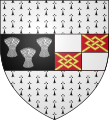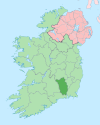Portal:County Kilkenny
The County Kilkenny Portal
County Kilkenny (Irish: Contae Chill Chainnigh) is a county in Ireland. It is in the province of Leinster and is part of the Southern Region. It is named after the city of Kilkenny. Kilkenny County Council is the local authority for the county. At the 2022 census the population of the county was 103,685. The county was based on the historic Gaelic kingdom of Ossory (Osraighe), which was coterminous with the Diocese of Ossory. (Full article...)
Selected articles

Kilkenny (Irish: Cill Chainnigh [ˌciːl̠ʲ ˈxan̠ʲəj], meaning 'church of Cainnech') is a city in County Kilkenny, Ireland. It is located in the South-East Region and in the province of Leinster. It is built on both banks of the River Nore. The 2022 census gave the population of Kilkenny as 27,184, the thirteenth-largest urban center in Ireland.
Kilkenny is a tourist destination, and its environs include historic buildings such as Kilkenny Castle, St Canice's Cathedral and round tower, Rothe House, Shee Alms House, Black Abbey, St. Mary's Cathedral, The Tholsel, St. Francis Abbey, Grace's Castle, and St. John's Priory. Kilkenny is also known for its craft and design workshops, the Watergate Theatre, public gardens and museums. Annual events include Kilkenny Arts Festival, the Cat Laughs comedy festival and music at the Kilkenny Roots Festival.
Kilkenny began with an early 6th-century ecclesiastical foundation within the Kingdom of Ossory. Following the 12th-century Norman invasion of Ireland, Kilkenny Castle and a series of walls were built to protect the burghers of what became a Norman merchant town. William Marshall, Lord of Leinster, gave Kilkenny a charter as a town in 1207. By the late 13th century, Kilkenny was under Hiberno-Norman control. The Statutes of Kilkenny, passed at Kilkenny in 1367, aimed to curb the decline of the Hiberno-Norman Lordship of Ireland. In 1609, King James I of England granted Kilkenny a Royal Charter, giving it the status of a city. Following the Irish Rebellion of 1641, the Irish Catholic Confederation, also known as the "Confederation of Kilkenny", was based in Kilkenny and lasted until the Cromwellian conquest of Ireland in 1649. From 1840 onwards, Kilkenny has not been administered as a city under local government law, but the Local Government Reform Act 2014 provides for "the continued use of the description city". (Full article...)
Selected history articles

Osraige (Old Irish) or Osraighe (Classical Irish), Osraí (Modern Irish), anglicized as Ossory, was a medieval Irish kingdom comprising what is now County Kilkenny and western County Laois, corresponding to the Diocese of Ossory. The home of the Osraige people, it existed from around the first century until the Norman invasion of Ireland in the 12th century. It was ruled by the Dál Birn dynasty, whose medieval descendants assumed the surname Mac Giolla Phádraig.
According to tradition, Osraige was founded by Óengus Osrithe in the 1st century and was originally within the province of Leinster. In the 5th century, the Corcu Loígde of Munster displaced the Dál Birn and brought Osraige under Munster's direct control. The Dál Birn returned to power in the 7th century, though Osraige remained nominally part of Munster until 859, when it achieved formal independence under the powerful king Cerball mac Dúnlainge. Osraige's rulers remained major players in Irish politics for the next three centuries, though they never vied for the High Kingship. In the early 12th century, dynastic infighting fragmented the kingdom, and it was re-adjoined to Leinster. The Normans under Strongbow invaded Ireland beginning in 1169, and most of Osraige collapsed under pressure from Norman leader William Marshal. The northern part of the kingdom, eventually known as Upper Ossory, survived intact under the hereditary lordship until the reign of King Henry VIII of England, when it was formally incorporated as a barony of the same name. (Full article...)
Selected landmarks articles

Rothe House /ˈroʊθ/ is a late 16th-century merchant's townhouse complex located in the city of Kilkenny, Ireland. The complex was built by John Rothe Fitz-Piers between 1594–1610 and is made up of three houses, three enclosed courtyards, and a large reconstructed garden with orchard. As a museum, it is accessible to the public.
Rothe House is the only remaining example of a complete burgage plot in Ireland, and considered to be nationally significant because of the range of original post-medieval features that survive. The property, an important element of Kilkenny's heritage, is owned by the Kilkenny Archaeological Society and houses some of the society's collection of artefacts relating to Kilkenny City, County and Ireland.
The garden to the rear of the house has been reconstructed to reflect a typical 17th-century garden. It features a well dug by Cistercian monks (based in Duiske Abbey in Graiguenamagh) who owned the property before the dissolution of monasteries. The burgage plot on which Rothe House was built survives intact – one of a few in such an unaltered state. Kilkenny's medieval city wall forms part of the curtilage of the Rothe House complex. (Full article...)
Selected geography articles
Crannagh (Irish: Crannach, meaning 'Abounding in Trees, or Woodland'), sometimes written Cranagh or Granagh, is a barony in the north western part of County Kilkenny, Ireland. It is one of 12 baronies in County Kilkenny. The size of the barony is 210.8 square kilometres (81.4 sq mi). There are 19 civil parishes in Crannagh, made up of 182 townlands. The chief town Freshford, with highest point at Clomantagh Hill. Crannagh lies at the north west of the county, with the baronies of Galmoy and Fassadinin to the north (whose chief towns are Galmoy and Castlecomer), and the barony of the Kilkenny to the east (whose chief town is Kilkenny) and Shillelogher to the south (whose chief town is Bennettsbridge). It is buffers County Tipperary on the west. The R693 road crosses the barony. (Full article...)
Bennettsbridge (Irish: Droichead Binéid, meaning 'Bennet's bridge') is a village in County Kilkenny in Ireland. It is situated on the River Nore 6 kilometres (3.7 mi) south of Kilkenny city, in the centre of the county. Bennettsbridge is a census town, and had population of 745 as of the 2016 census. (Full article...)
The River Suir (/ʃʊər/ SHOOR; Irish: an tSiúr [ənʲ ˈtʲuːɾˠ] or Abhainn na Siúire [ˌəun̠ʲ n̪ˠə ˈʃuːɾʲə]) is a river in Ireland that flows into the Atlantic Ocean through Waterford after a distance of 185 kilometres (115 mi). The catchment area of the Suir is 3,610 km2. Its long term average flow rate is 76.9 cubic metres per second (m3/s), about twice the flow of either the River Barrow (37.4 m3/s) or the River Nore (42.9 m3/s) before these join, but a little less than the Barrow's flow when it meets the Suir 20 km downstream (over 80 m3/s). (Full article...)

Jenkinstown Park is a park in County Kilkenny, Ireland. It is situated off the N78 road about 10 km north of the city of Kilkenny and 11 km south of Castlecomer. (Full article...)
Selected quotation
"If you ever go to Kilkenny, Remember the Hole in the Wall, You may there get drunk for a penny, Or tipsy for nothing at all."
|
— Unknown, circa 18th Century. |
Selected Did you know

- ... that Henry Shefflin (pictured) has won seven All-Ireland titles?
- ...Kjarvalr Írakonungr, a figure in the Norse sagas who appears as an ancestor of many prominent Icelandic families, is identified with Cerball mac Dúnlainge. (Full article...)
Selected slideshow image
Selected biography articles
Jeremy Hickey (also known as Rarely Seen Above Ground—abbreviated as R.S.A.G.—) is an Irish multi-instrumentalist and producer from Kilkenny. He has released four albums and one EP. Rarely Seen Above Ground (2007) Organic Sampler (2008) Be It Right Or Wrong (2010)Rotate EP (2013) and Chroma (2020).
R.S.A.G released his debut double album Organic Sampler which received a Choice Music Prize nomination for Irish Album of the Year 2008 along with a 5 star review from the Irish Times. His follow up "Be It Right Or Wrong" was also received with critical acclaimed and earned him 5 stars in the RTE ten magazine. 2013's "Rotate EP" was named as one Nialler 9's top 10 EP's that year. His latest album "Chroma" which is hailed as his finest piece of work to date was released on 29 May. The Irish Times calling it 'One of the best Irish albums of 2020'. His live show has been a staple of the Irish Festival scene for years showcasing his talent as a live performer. He has performed at several festivals, including Castlepalooza, Electric Picnic and Body & Soul and is rumoured to be "one of the most innovative and astonishing Irish musicians around" Entertainment.ie (Full article...)
Abraham Colles (23 July 1773 – 16 November 1843) was Professor of Anatomy, Surgery and Physiology at the Royal College of Surgeons in Ireland (RCSI) and the President of RCSI in 1802 and 1830. A prestigious Colles Medal & Travelling Fellowship in Surgery is awarded competitively annually to an Irish surgical trainee embarking on higher specialist training abroad before returning to establish practice in Ireland. (Full article...)
Colm Ó Lochlainn (1892 – 26 June 1972) was an Irish printer, typographer, collector of Irish ballads and traditional Irish Uilleann piper. He was notably the author of Irish Street Ballads published in 1939 and More Irish Street Ballads in 1965. (Full article...)
Brian Mac Giolla Phádraig (c. 1580 – 1653) was an Irish poet and priest. He is not to be confused with any of the Barons of Upper Ossory, his relations, several of whom bore the same name in Irish. (Full article...)
Selected sport articles
Liz Neary (born 1951 in Kilkenny, Ireland) is a retired Irish sportsperson. She played camogie at various times with her local clubs St. Paul's and Austin Stacks and was a member of the Kilkenny senior inter-county team from 1970 until 1987. Neary is regarded as one of the greatest players of all-time.
In a senior inter-county career that lasted for nineteen years she won seven All-Ireland medals, five National League medals and five Gael Linn Interprovincial medals. With her two clubs St. Paul's and Austin Stack's she collected a huge haul of twenty-one county titles and six All-Ireland club medals. (Full article...)
Related portals
Associated Wikimedia
The following Wikimedia Foundation sister projects provide more on this subject:
-
Commons
Free media repository -
Wikibooks
Free textbooks and manuals -
Wikidata
Free knowledge base -
Wikinews
Free-content news -
Wikiquote
Collection of quotations -
Wikisource
Free-content library -
Wikiversity
Free learning tools -
Wikivoyage
Free travel guide -
Wiktionary
Dictionary and thesaurus





























































